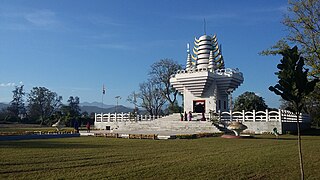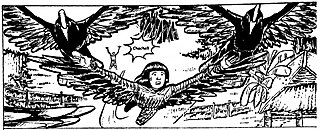
Manipur is a state in northeast India, with the city of Imphal as its capital. It is bounded by the Indian states of Nagaland to the north, Mizoram to the south and Assam to the west. It also borders two regions of Myanmar, Sagaing Region to the east and Chin State to the south. The state covers an area of 22,327 km2 (8,621 sq mi). The official and most widely spoken language is the Meitei language. Native to the Meitei people, it is also used as a lingua franca by smaller communities, who speak a variety of other Tibeto-Burman languages. Manipur has been at the crossroads of Asian economic and cultural exchange for more than 2,500 years. This exchange connects the Indian subcontinent and Central Asia to Southeast Asia, East Asia, Siberia, regions in the Arctic, Micronesia and Polynesia enabling migration of people, cultures and religions.
Kalakshetra Manipur, is an Indian theatre group located in Manipur It was established on 19 July 1969 by Heisnam Kanhailal as Founder and Director and his wife Heisnam Sabitri as co-founder. It has been registered under Societies' Registration Act XXI of 1860 with its No. 1149 of 1972. Their eldest son Heisnam Tomba has taken over as the current Director.

Heisnam Kanhailal was an Indian art theatre personality. For his work, he was awarded the Padma Shri civilian award in 2004 and the Padma Bhushan civilian award in 2016 by the Government of India. He was the founder-director of Kalakshetra Manipur, a theatre laboratory established in 1969 that explores a new vocabulary in the existing language of theatre.

Meitei literature, also known as Manipuri literature, is literature written in the Meitei language of Manipur. An ancient institution of learning, the Luwang Nonghumsang, later known as the Pandit Loishang, collected sources of indigenous Meitei knowledge and philosophy until the 18th century. Writing by Meiteis is assumed to go back to the Kingdom of Kangleipak in the early 12th century. The Meitei script is a Brahmic abugida. It is known only from the Puya manuscripts discovered in the first half of the 20th century. Manuscripts of the 18th and 19th centuries were written using the Bengali alphabet. The existence of the Meitei script in the 15th-century hinges on the authenticity of an inscription dated to the reign of Senbi Kiyamba. The first printed Manipuri book, Manipurer Itihas, appeared in 1890 from the Baptist Mission Press, Calcutta. Though the kings of Manipur had established contact with the British from the middle of the eighteenth century onward the real impact of the contact came much later. Johnstone Middle English School, based on the western system of education, was started in 1885 at Imphal, and in 1891 Manipur lost its independence to the British. British domination facilitated the introduction of new systems in the civil, political and educational spheres, which hastened the process of modernization in Manipur, exposed as it was to new ideas and influences.

Sabitri Heisnam is an Indian stage actor and one of the notable theatre personalities in Manipuri theatre. She has also acted in the critically acclaimed short film, Scribbles on Akka (2000), directed by Madhusree Dutta, which won the IDPA Award, best script award at Shanghai International Film Festival and the National Film Award for Best Anthropological Film. She is a recipient of the Sangeet Natak Akademi Award of 1991. The Government of India awarded her the fourth highest civilian honour of the Padma Shri, in 2008, for her contributions to Manipuri theatre.

Gurumayum Bonny Sharma is an Indian actor and singer who predominantly appears in Manipuri films. He is famous for movies 'Yaiskul Pakhang Angaoba', 'Beragee Bomb', 'Mr Khadang'. He is a resident of Keishamthong Maning Longjam Leikai, Imphal, Manipur. He has also worked in the Shumang Kumheis including Kunti series, Nongallamdaisida, Opium War, and Pizza.

Numit Kappa is an ancient Meitei language mythological epic literary work. The work is believed to be written around or before 33 AD. It is written in the form of partial poetry and partial prose.

Irai Leima is a goddess in Sanamahism, the indigenous religion of Manipur. She is the goddess and the divine female personification of water and aquatic life. She is the consort of Irai Ningthou. Both are regarded as the divine spirits of water bodies. She is also considered to be in charge of diseases.

Yenakha Paotapi or Yenakha Paodabi Saijin Polibi, also known as the evil eavesdropper, is an old demoness. Stories often show her as an evil spirit. She lingers around the eaves of roofs in Meitei mythology and folklore of Ancient Kangleipak. She is described as the one who interferes everywhere. Legend says that she could not live with human beings. Instead, she lives like a dog or a jackal, sitting on graves. In some cases, she is depicted as a minor goddess in the Meitei religion.

Keibu Keioiba, also known as Kabui Keioiba, is a mythical creature with the head of a tiger and the body of a human in the Meitei mythology and folklore of Manipur. According to legend, he was once a skilful priest named Kabui Salang Maiba. He used witchcraft to turn himself into a ferocious tiger. As punishment of his pride, he could not completely turn back to his original human form.
Akongjamba was a nobleman in Ancient Moirang in Meitei mythology. He was a lover of the harvest Goddess Phouoibi. According to mythology, fate did not permit the lovers to unite, so they reincarnated. The lives of the two legendary lovers were believed to be enacted by Thangjing as a part of the epic cycles of incarnations.

The ancient legend of Khuyol Haoba and Yaithing Konu is one of the epic cycles of incarnations of Meitei mythology and folklore, that is originated from Moirang kingdom of Ancient Kangleipak. It concerns the fateful love of Khuyol Haoba, an orphan man, for the beautiful Yaithing Konu. Khuyol Haoba was the son of late Khundouremba, a court official of Moirang. Yaithing Konu was the daughter of Luwang Huiningsumba, an influential nobleman of Moirang.

Keibu Keioiba, also known as Kabui Keioiba, is a 2009 Manipuri animation feature film, directed by Bhumenjoy Konsam. It is the first Manipuri animation film, based on the Meitei folklore. It was screened in the 11th Mumbai International Film Festival (MIFF) in 2010, under the aegis of the Ministry of Information and Broadcasting.

The ancient legend of Khamba and Thoibi is a classic, as well as one of the epic cycles of incarnations of Meitei mythology and folklore, that is originated from Ancient Moirang kingdom of Ancient Kangleipak . It is referred to as the "national romantic legend of Manipur" by Indian scholar Suniti Kumar Chatterjee.

The Meitei folktales, also sometimes referred to as the Manipuri folktales, are the large collections of folk stories developed from the Meitei culture since Ancient Kangleipak. Folktales are called "funga wari", literally meaning "stories of kitchen furnace or stove" in Meitei language. In early times, in the Meitei households, children must have gathered around the kitchen fire, listening to the stories narrated by the elders. Generally, Meitei folktales were developed from the creativity of the old folks, especially the grandparents, who narrated the children the diverse sagas of varying genres.

The legend of Sandrembi and Chaisra or Sanarembi and Chaisra is a folktale of the Meitei ethnicity of Ancient Kangleipak. It is a story of the clash between two stepsisters, Sandrembi (Sanarembi), the elder, and Chaisra, the younger, born to the same father but different mothers. Sandrembi, the protagonist, is a young lady, living in forsaken environment and in dire circumstances that are changed into a remarkable fortune. She is portrayed as a person having the nature of God like mind.

The culture of Meitei civilization evolved over thousands of years, beginning in Ancient Kangleipak, continuing most notably into Medieval Kangleipak, while influencing the neighboring states and kingdoms, till present times.

Thabaton, lovingly called as Thaba, was a lady in Meitei mythology and folklore of Ancient Kangleipak. She had seven elder brothers who took care of her at every cost. She was kidnapped by Keibu Keioiba, a tiger headed man, during the absence of her siblings. After staying at the captivity of the beast for some time, she was later rescued and freed from bondage by her brothers.

The story of Uchek Langmeitong or Chekla Langmeitong is a Meitei folktale of Ancient Kangleipak. It is the story of a girl named "Hayainu" who turned herself into a Langmeitong as she was unable to suffer the ill treatments of her cruel stepmother.

Meitei language, officially and formally known as Manipuri language, is one of the official languages of the state government of Assam. It serves as the additional official language in all the three districts of the Barak Valley as well as in the Hojai district of Assam.
















